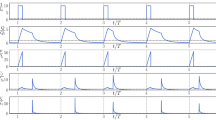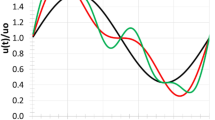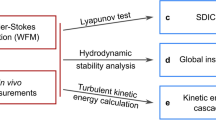Abstract
Flows through pipes and channels are, in practice, almost always turbulent, and the multiscale eddying motion is responsible for a major part of the encountered friction losses and pumping costs1. Conversely, for pulsatile flows, in particular for aortic blood flow, turbulence levels remain low despite relatively large peak velocities. For aortic blood flow, high turbulence levels are intolerable as they would damage the shear-sensitive endothelial cell layer2,3,4,5. Here we show that turbulence in ordinary pipe flow is diminished if the flow is driven in a pulsatile mode that incorporates all the key features of the cardiac waveform. At Reynolds numbers comparable to those of aortic blood flow, turbulence is largely inhibited, whereas at much higher speeds, the turbulent drag is reduced by more than 25%. This specific operation mode is more efficient when compared with steady driving, which is the present situation for virtually all fluid transport processes ranging from heating circuits to water, gas and oil pipelines.
This is a preview of subscription content, access via your institution
Access options
Access Nature and 54 other Nature Portfolio journals
Get Nature+, our best-value online-access subscription
$29.99 / 30 days
cancel any time
Subscribe to this journal
Receive 51 print issues and online access
$199.00 per year
only $3.90 per issue
Buy this article
- Purchase on Springer Link
- Instant access to full article PDF
Prices may be subject to local taxes which are calculated during checkout



Similar content being viewed by others
Data availability
The datasets generated and analysed during the current study are freely available in the Zenodo repository (https://doi.org/10.5281/zenodo.7828996)35.
Code availability
The numerical simulations were conducted with the open-source code nsPipeFlow, distributed under the terms of the GNU General Public License v.3. A detailed description of the code and user guide are provided in ref. 30. The code version used in this study and an initial condition to start the simulations are openly available in the Zenodo repository (https://doi.org/10.5281/zenodo.7828996)35.
References
Kühnen, J. et al. Destabilizing turbulence in pipe flow. Nat. Phys. 14, 386–390 (2018).
Davies, P. F., Remuzzi, A., Gordon, E. J., Dewey, C. F.Jr & Gimbrone, M. A. Turbulent fluid shear stress induces vascular endothelial cell turnover in vitro. Proc. Natl Acad. Sci. USA 83, 2114–2117 (1986).
DePaola, N., Gimbrone, M. A. Jr, Davies, P. F.Jr & Dewey, C. F. Vascular endothelium responds to fluid shear stress gradients. Arterioscler. Thromb. J. Vasc. Biol. 12, 1254–1257 (1992).
Davies, P. F. Hemodynamic shear stress and the endothelium in cardiovascular pathophysiology. Nat. Clin. Pract. Cardiovasc. Med. 6, 16–26 (2009).
Gimbrone, M. A.Jr & García-Cardeña, G. Endothelial cell dysfunction and the pathobiology of atherosclerosis. Circ. Res. 118, 620–636 (2016).
Frenning, L. Pump Life Cycle Costs: A Guide to LCC Analysis for Pumping Systems (Hydraulic Institute, Europump, and the US Department of Energy’s Office of Industrial Technologies, 2001).
Avila, K. et al. The onset of turbulence in pipe flow. Science 333, 192–196 (2011).
Ku, D. N. et al. Blood flow in arteries. Annu. Rev. Fluid Mech. 29, 399–434 (1997).
Stalder, A. F. et al. Assessment of flow instabilities in the healthy aorta using flow-sensitive MRI. J. Magn. Reson. Imaging 33, 839–846 (2011).
Nerem, R. M., Rumbergerr, J. A. Jr, Gross, D. R., Hamlin, R. L. & Geiger, G. L. Hot-film anemometer velocity measurements of arterial blood flow in horses. Circ. Res. 34, 193–203 (1974).
Brunton, S. L. & Noack, B. R. Closed-loop turbulence control: progress and challenges. Appl. Mech. Rev. 67, 050801 (2015).
Karniadakis, G. & Choi, K.-S. Mechanisms on transverse motions in turbulent wall flows. Annu. Rev. Fluid Mech. 35, 45–62 (2003).
Min, T., Kang, S. M., Speyer, J. L. & Kim, J. Sustained sub-laminar drag in a fully developed channel flow. J. Fluid Mech. 558, 309–318 (2006).
Nakanishi, R., Mamori, H. & Fukagata, K. Relaminarization of turbulent channel flow using traveling wave-like wall deformation. Int. J. Heat Fluid Flow 35, 152–159 (2012).
Auteri, F., Baron, A., Belan, M., Campanardi, G. & Quadrio, M. Experimental assessment of drag reduction by traveling waves in a turbulent pipe flow. Phys. Fluids 22, 115103 (2010).
Kasagi, N., Suzuki, Y. & Fukagata, K. Microelectromechanical systems-based feedback control of turbulence for skin friction reduction. Annu. Rev. Fluid Mech. 41, 231–251 (2009).
García-Mayoral, R. & Jiménez, J. Drag reduction by riblets. Philos. Trans. R. Soc. Math. Phys. Eng. Sci. 369, 1412–1427 (2011).
Virk, P. S., Mickley, H. S. & Smith, K. A. The ultimate asymptote and mean flow structure in Toms’ phenomenon. J. Appl. Mech. 37, 488–493 (1970).
Choueiri, G. H., Lopez, J. M. & Hof, B. Exceeding the asymptotic limit of polymer drag reduction. Phys. Rev. Lett. 120, 124501 (2018).
He, S. & Jackson, J. D. A study of turbulence under conditions of transient flow in a pipe. J. Fluid Mech. 408, 1–38 (2000).
Greenblatt, D. & Moss, E. A. Rapid temporal acceleration of a turbulent pipe flow. J. Fluid Mech. 514, 65–75 (2004).
He, S., Ariyaratne, C. & Vardy, A. E. Wall shear stress in accelerating turbulent pipe flow. J. Fluid Mech. 685, 440–460 (2011).
He, S. & Seddighi, M. Turbulence in transient channel flow. J. Fluid Mech. 715, 60–102 (2013).
He, K., Seddighi, M. & He, S. DNS study of a pipe flow following a step increase in flow rate. Int. J. Heat Fluid Flow 57, 130–141 (2016).
Mathur, A. et al. Temporal acceleration of a turbulent channel flow. J. Fluid Mech. 835, 471–490 (2018).
Cheng, Z., Jelly, T. O., Illingworth, S. J., Marusic, I. & Ooi, A. S. H. Forcing frequency effects on turbulence dynamics in pulsatile pipe flow. Int. J. Heat Fluid Flow 82, 108538 (2020).
Ariyaratne, C., He, S. & Vardy, A. E. Wall friction and turbulence dynamics in decelerating pipe flows. J. Hydraul. Res. 48, 810–821 (2010).
Kobayashi, W., Shimura, T., Mitsuishi, A., Iwamoto, K. & Murata, A. Prediction of the drag reduction effect of pulsating pipe flow based on machine learning. Int. J. Heat Fluid Flow 88, 108783 (2021).
Foggi Rota, G., Monti, A., Rosti, M. E. & Quadrio, M. Saving energy in turbulent flows with unsteady pumping. Sci. Rep. 13, 1299 (2023).
Bürk, J. et al. Evaluation of 3D blood flow patterns and wall shear stress in the normal and dilated thoracic aorta using flow-sensitive 4D CMR. J Cardiovasc. Magn. Reson. 14, 84 (2012).
Stein, P. D. & Sabbah, H. N. Turbulent blood flow in the ascending aorta of humans with normal and diseased aortic valves. Circ. Res. 39, 58–65 (1976).
López, J. M. et al. nsCouette—a high-performance code for direct numerical simulations of turbulent Taylor–Couette flow. SoftwareX 11, 100395 (2020).
Blasius, H. in Mitteilungen über Forschungsarbeiten auf dem Gebiete des Ingenieurwesens Vol. 131, 1–41 (Springer, 1913); https://doi.org/10.1007/978-3-662-02239-9_1.
Tanaka, M., Girard, G., Davis, R., Peuto, A. & Bignell, N. Recommended table for the density of water between 0 °C and 40 °C based on recent experimental reports. Metrologia 38, 301 (2001).
Scarselli, D., Lopez, J. M., Varshney, A. & Hof, B. Turbulence suppression by cardiac cycle inspired pulsatile driving of pipe flow: datasets and numerical code used to perform the simulations. Zenodo https://doi.org/10.5281/zenodo.7828996 (2023).
Acknowledgements
We acknowledge the assistance of the Miba machine shop and the team of the ISTA-HPC cluster. We thank M. Quadrio for the discussions. The work was supported by the Simons Foundation (grant no. 662960) and by the Austrian Science Fund (grant no. I4188-N30), within Deutsche Forschungsgemeinschaft research unit FOR 2688.
Author information
Authors and Affiliations
Contributions
B.H. supervised the project. D.S. and A.V. designed and performed the experiment. D.S. analysed the experimental data. J.M.L. designed and performed the computer simulations of the Navier–Stokes equations and analysed the numerical results. D.S., J.M.L., A.V. and B.H. wrote the paper.
Corresponding author
Ethics declarations
Competing interests
The authors declare no competing interests.
Peer review
Peer review information
Nature thanks Yongyun Hwang and the other, anonymous, reviewer(s) for their contribution to the peer review of this work.
Additional information
Extended data
is available for this paper at https://doi.org/10.1038/s41586-023-06399-5.
Publisher’s note Springer Nature remains neutral with regard to jurisdictional claims in published maps and institutional affiliations.
Extended data figures and tables
Extended Data Fig. 1 Sketch of the experimental setup.
Drawing not to scale.
Extended Data Fig. 2 Waveform, pressure and power signal.
Signals from the optimal cycle (Fig. 2c) measured in experiments. (a) Waveform based on the linear piston speed and (b) pressure drop Δp measured over the test section. The signal from all the 100 cycles measured is shown in blue, while the phase average is represented in orange. The number of samples per cycles is N = 325. For comparison, we report also the pressure drop computed with the DNS for the same cycle (gray dotted line). In this case the signal is obtained by phase-averaging the available 8 cycles. (c) The power input for the same waveform. The values for the 100 cycles in experiments are shown in blue, the ensemble average in red and the power input in DNS is given by the grey doted line.
Extended Data Fig. 3 Comparison of the values of (a) R and (b) S between experiments (blue histogram) and DNS.
For the optimal cycle (Fig. 2c, main text) the histogram shows the distribution of the values obtained from 100 runs. The orange, dashed line shows the mean of the available corresponding DNS cycles.
Rights and permissions
Springer Nature or its licensor (e.g. a society or other partner) holds exclusive rights to this article under a publishing agreement with the author(s) or other rightsholder(s); author self-archiving of the accepted manuscript version of this article is solely governed by the terms of such publishing agreement and applicable law.
About this article
Cite this article
Scarselli, D., Lopez, J.M., Varshney, A. et al. Turbulence suppression by cardiac-cycle-inspired driving of pipe flow. Nature 621, 71–74 (2023). https://doi.org/10.1038/s41586-023-06399-5
Received:
Accepted:
Published:
Issue Date:
DOI: https://doi.org/10.1038/s41586-023-06399-5
This article is cited by
-
Ca2+ oscillation in vascular smooth muscle cells control myogenic spontaneous vasomotion and counteract post-ischemic no-reflow
Communications Biology (2024)
-
Cardiac cycle inspires optimized pipe flow
Nature (2023)
-
Heart-inspired pump can slash energy demand
Nature India (2023)
Comments
By submitting a comment you agree to abide by our Terms and Community Guidelines. If you find something abusive or that does not comply with our terms or guidelines please flag it as inappropriate.



